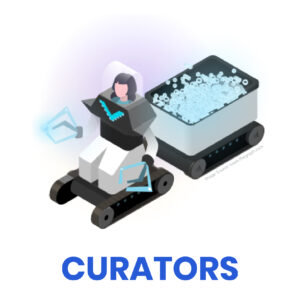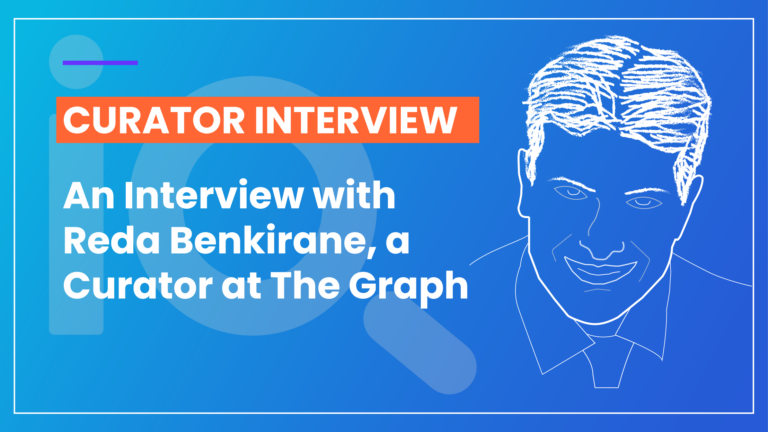We interviewed Reda Benkirane, a Curator at The Graph, to better understand what Curators do and how their work relates to the larger ecosystem.
In order to develop decentralized applications, or dApps, developers need access to accurate and reliable pools of data, called subgraphs, which are created by extracting information held on a blockchain or a storage network.
Since subgraphs, which are sometimes referred to as “open APIs,” can be created by anyone, someone must act to verify the subgraph’s accuracy and reliability. This is what Curators primarily do: “They use their knowledge of the blockchain ecosystem… to identify the most reliable data sources.”
According to The Graph, “Curators are vital to the protocol [because] they signal on specific subgraphs to indicate to Indexers which data should be indexed.”
To better understand what Curators do and how they operate, we interviewed Reda Benkirane (Twitter and Medium) who is an active Curator on The Graph.

GRTiQ: How would you describe the role of Curators in The Graph’s ecosystem?
Reda: I would say that Curators have the role of assessing the quality of subgraphs that exist in the decentralized network. Curators check to see if the subgraphs are complete and useful. Once they complete the assessment, the Curator can choose to signal on the subgraph, by staking some GRT on the subgraph bonding curve. Therefore, a Curator’s role is to signal to Indexers which subgraphs are the most useful, and which ones the Indexer might decide to index. If the Indexer decides to index the subgraph, then the Curator can earn rewards through query fees.
GRTiQ: Can you describe how Curators go about their work on subgraphs?
Reda: Curators need to know a bit of GraphQL to be able to assess a subgraph’s quality. Without going into too much technical detail, as a Curator I spend my workday looking for useful subgraphs that I can then signal to Indexers in an effort to earn query fees.
GRTiQ: When does a Curator know when a certain subgraph should be indexed?
Reda: To keep things very simple, the subgraphs are made using GraphQL and are built with what are called a Graph QL manifest file and GraphQL schema file. As a Curator, I assess the quality of both the manifest file and the schema file based on three primary criteria: complexity, completeness, and accuracy.
GRTiQ: What is the working relationship between Curators and Indexers?
Reda: The relationship between Curators and Indexers is very close, because Curators will signal the best subgraphs to index to the Indexers, which creates a win-win situation for both. Currently, there is a lot of networking between Curators and Indexers within The Graph community, starting with the Discord server which is a great resource and is also a good place for Curators to start and create relationships with different Indexers.
GRTiQ: How important are Delegators to The Graph and the work of Curators?
Reda: Delegators are very important to The Graph because they secure the network and bring their delegation power to Indexers, by staking GRT with Indexers, which enables Indexers to query as many subgraphs as possible. Delegators are key to the ecosystem!
GRTiQ: What do you envision when you think about the future of The Graph?
Reda: The future is bright for The Graph. Technically, it could one day index all blockchain data and serve all the participants in the broader blockchain ecosystem. But there is still a lot of work to do and we’re just at the beginning. A lot of questions still need to be answered. But The Graph is in a great position to play a major role in the future of blockchain data.
GRTiQ: Do you see any challenges ahead for The Graph?
Reda: The Graph is using a unique technology and is it still very early in the market. It is certainly possible that competition will emerge or that technical challenges could arise. But it is all very exciting because the story is still being written and we have the chance to participate.
GRTiQ: What’s the next big thing members of the Delegator community should watch for?
Reda: The Graph has announced that in addition to Ethereum, there is a list of new L1 blockchain that we are now going to start indexing. This is a major move to achieve the target of indexing as much blockchain data as possible.
GRTiQ: Lastly, are there any common misunderstandings about Curators that you would like to correct?
Reda: The role of the Curator is not clear or well-understood yet because the curation market is not open yet. There is not a lot of information about that. But as more subgraphs become available in the decentralized network, I expect all this to change.
Reda Benkirane is a telecom engineer and lives in Switzerland.
WANT MORE?
Receive New Content
Direct to Your Inbox
DISCLOSURE: GRTIQ is not affiliated, associated, authorized, endorsed by, or in any other way connected with The Graph, or any of its subsidiaries or affiliates. This material has been prepared for information purposes only, and it is not intended to provide, and should not be relied upon for, tax, legal, financial, or investment advice. The content for this material is developed from sources believed to be providing accurate information. The Graph token holders should do their own research regarding individual Indexers and the risks, including objectives, charges, and expenses, associated with the purchase of GRT or the delegation of GRT.
©GRTIQ.com
